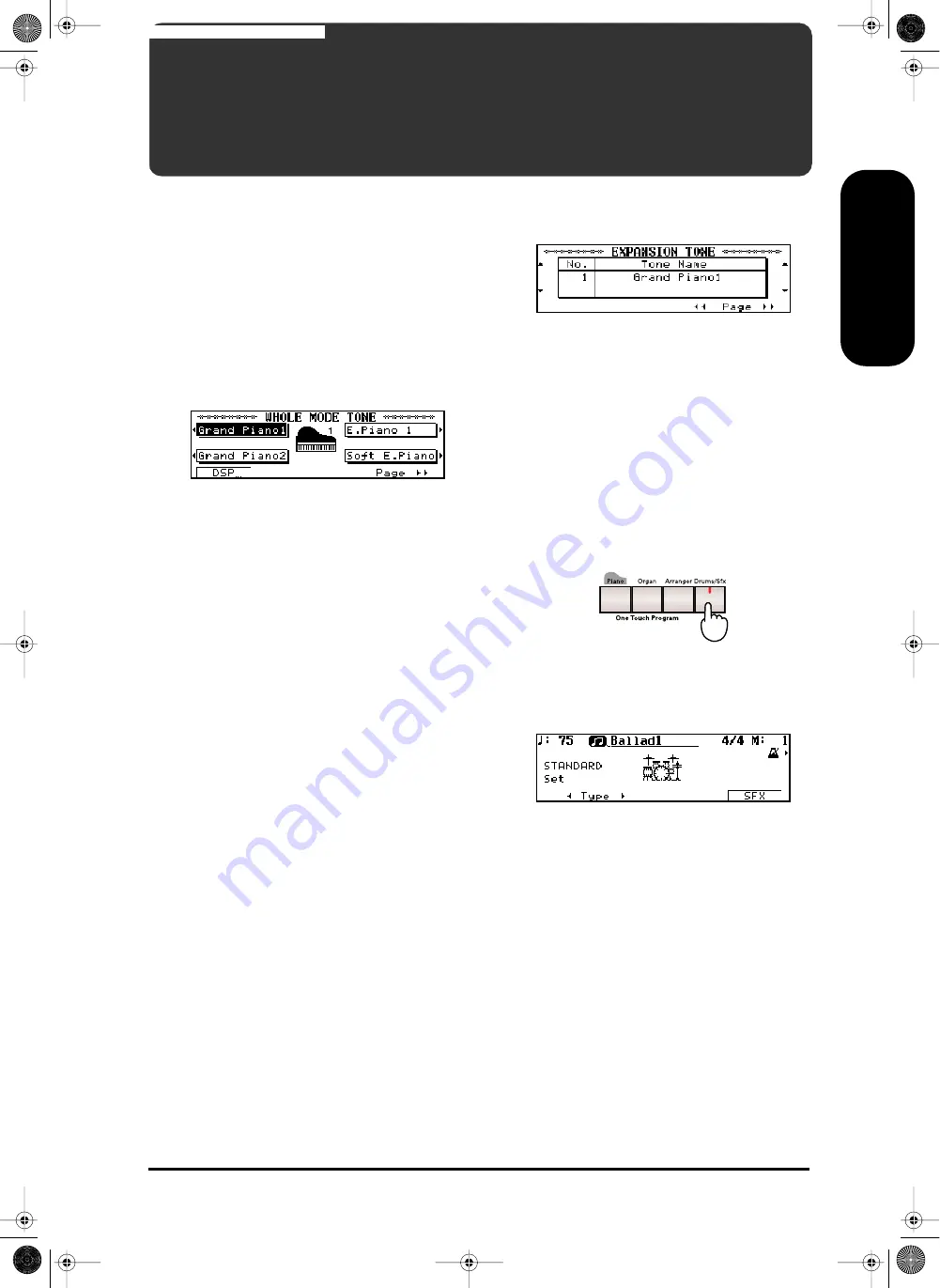
19
KR-3 – Pitch Bend and Transpose
ENGLISH
ENGLISH
ENGLISH
ENGLISH
6.1 Selecting Tones
The KR-3 comes with a host of instrument sounds
(called Tones). These Tones are divided into eight
categories, called Groups.
Selecting “normal” Tones
1.
Press the TONE button of the Group that contains
the Tone you need.
The button’s indicator light will go on, and a Tone
select screen (e.g. Whole Mode Tone) will be dis-
played.
Each Tone Group contains several Tones.
2.
Select a Tone by pressing the buttons to the side of
the display screen.
The name of the Tone selected will be highlighted on
the display. Play a few notes on the keyboard to con-
firm that the Tone is what you had in mind.
The Tone Select screen is composed of multiple pages.
Use <
√√
PAGE> and <PAGE
®®
> to turn to
another page.
Note: If you want to try out several Tones from a Tone
Group, pressing the [HOLD] button will lock the Tone
Select screen and keep it from disappearing after a few
seconds.
Note: See “Normal Tones” at the end of this manual for the
number and kinds of Tones each Group contains.
You may wonder why we use the term “Normal Tones”
rather than just “Tones”. That is because the instruc-
tions above do not give you access to all Tones the
KR-3 contains. See “Selecting Expansion Tones” for
more details about how to access
all
Tones.
Note: See also “Selecting Tones for the Upper and Lower
parts” on page 21 for how to assign Tones in Split mode.
Selecting Expansion Tones
Expansion Tones can only be assigned to the Upper
part of the keyboard (Whole Keyboard, Split, and
Arranger modes).
Caution—
Expansion Tones are only temporarily
selected and cannot be written to a Music Assistant
memory (see page 44). Whenever you select another
mode (for example, if you change from Whole mode
to Split mode), the Upper part returns to last “nor-
mal” Tone you selected.
1.
Press [UTILITY] and use <
√√
PAGE> or
<PAGE
®®
> to select the following display page.
2.
Use the buttons to the left and right of the display
to select a Tone.
See “Expansion Tones” at the end of this manual for a
list of the available Tones.
Note: You can use Expansion Tones for recording the mel-
ody with the KR-3’s Composer (see page 33).
Drum sounds and sound effects —
[DRUMS/SFX]
Instead of playing melodies, you can also “drum” on
the KR-3’s keyboard, or play sound effects like train
noises, helicopter sounds, etc.
Press the [DRUMS/SFX] button (indicator lights).
The display switches to the “Drum Screen”. Every key
is now assigned to a different drum or percussion
sound. Play a few notes and listen – and watch the
display.
Note: See “Drum Sets” at the end of this manual for details
about the assignments of drum sounds and sound effects to
the keyboard.
Press the [DRUMS/SFX] button once more (or the
[EXIT] button), to return to the previous screen.
Toggling between drum sounds and sound effects
1.
If necessary, press [DRUMS/SFX] again (indicator
must light).
2.
Press <SFX>.
The display will switch to the “SFX Screen”. Play a few
notes on the keyboard. This time, you will hear sound
effects rather than drum sounds. Again, the display
will show you pictures of the sounds being played.
3.
Press <Drums>.
The display jumps to the Drum Screen. With each
press of the button you will toggle between drums
sounds and effects.
6. Tones and related functions
KR-3_Book Page 19 Wednesday, July 10, 2002 10:27 AM






























